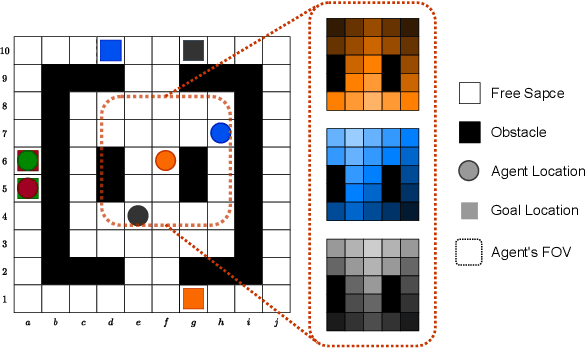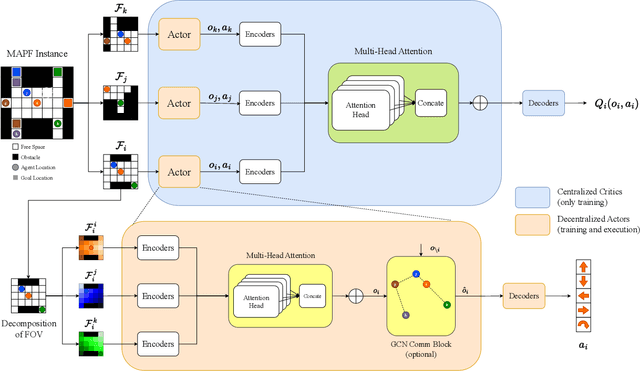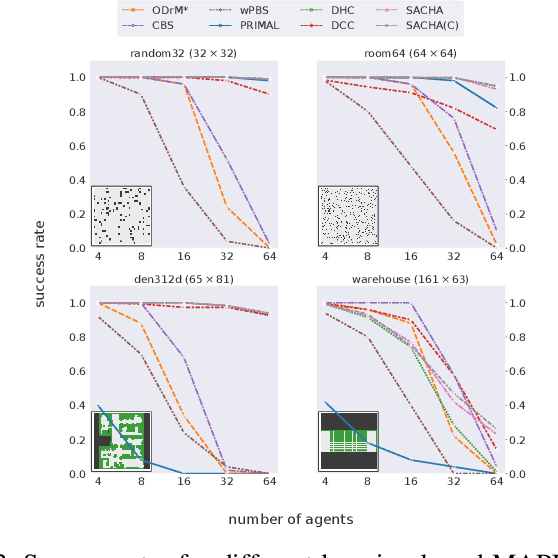Hang Ma
MFC-EQ: Mean-Field Control with Envelope Q-Learning for Moving Decentralized Agents in Formation
Oct 15, 2024Abstract:We study a decentralized version of Moving Agents in Formation (MAiF), a variant of Multi-Agent Path Finding aiming to plan collision-free paths for multiple agents with the dual objectives of reaching their goals quickly while maintaining a desired formation. The agents must balance these objectives under conditions of partial observation and limited communication. The formation maintenance depends on the joint state of all agents, whose dimensionality increases exponentially with the number of agents, rendering the learning process intractable. Additionally, learning a single policy that can accommodate different linear preferences for these two objectives presents a significant challenge. In this paper, we propose Mean-Field Control with Envelop $Q$-learning (MFC-EQ), a scalable and adaptable learning framework for this bi-objective multi-agent problem. We approximate the dynamics of all agents using mean-field theory while learning a universal preference-agnostic policy through envelop $Q$-learning. Our empirical evaluation of MFC-EQ across numerous instances shows that it outperforms state-of-the-art centralized MAiF baselines. Furthermore, MFC-EQ effectively handles more complex scenarios where the desired formation changes dynamically -- a challenge that existing MAiF planners cannot address.
Benchmarking Large Neighborhood Search for Multi-Agent Path Finding
Jul 12, 2024Abstract:Multi-Agent Path Finding (MAPF) aims to arrange collision-free goal-reaching paths for a group of agents. Anytime MAPF solvers based on large neighborhood search (LNS) have gained prominence recently due to their flexibility and scalability. Neighborhood selection strategy is crucial to the success of MAPF-LNS and a flurry of methods have been proposed. However, several pitfalls exist and hinder a comprehensive evaluation of these new methods, which mainly include: 1) Lower than actual or incorrect baseline performance; 2) Lack of a unified evaluation setting and criterion; 3) Lack of a codebase or executable model for supervised learning methods. To overcome these challenges, we conduct a fair comparison across prominent methods on the same benchmark and hyperparameter search settings. Additionally, we propose a simple neighborhood selection strategy which marks a clear advancement in terms of runtime efficiency in large maps with large number of agents. Our benchmarking evaluation promotes new challenges for existing learning based methods and presents opportunities for future research when machine learning is integrated with MAPF-LNS. Code and data are available at https://github.com/ChristinaTan0704/mapf-lns-benchmark.
MapTracker: Tracking with Strided Memory Fusion for Consistent Vector HD Mapping
Mar 23, 2024



Abstract:This paper presents a vector HD-mapping algorithm that formulates the mapping as a tracking task and uses a history of memory latents to ensure consistent reconstructions over time. Our method, MapTracker, accumulates a sensor stream into memory buffers of two latent representations: 1) Raster latents in the bird's-eye-view (BEV) space and 2) Vector latents over the road elements (i.e., pedestrian-crossings, lane-dividers, and road-boundaries). The approach borrows the query propagation paradigm from the tracking literature that explicitly associates tracked road elements from the previous frame to the current, while fusing a subset of memory latents selected with distance strides to further enhance temporal consistency. A vector latent is decoded to reconstruct the geometry of a road element. The paper further makes benchmark contributions by 1) Improving processing code for existing datasets to produce consistent ground truth with temporal alignments and 2) Augmenting existing mAP metrics with consistency checks. MapTracker significantly outperforms existing methods on both nuScenes and Agroverse2 datasets by over 8% and 19% on the conventional and the new consistency-aware metrics, respectively. The code will be available on our project page: https://map-tracker.github.io.
Multi-Robot Connected Fermat Spiral Coverage
Mar 20, 2024Abstract:We introduce the Multi-Robot Connected Fermat Spiral (MCFS), a novel algorithmic framework for Multi-Robot Coverage Path Planning (MCPP) that adapts Connected Fermat Spiral (CFS) from the computer graphics community to multi-robot coordination for the first time. MCFS uniquely enables the orchestration of multiple robots to generate coverage paths that contour around arbitrarily shaped obstacles, a feature that is notably lacking in traditional methods. Our framework not only enhances area coverage and optimizes task performance, particularly in terms of makespan, for workspaces rich in irregular obstacles but also addresses the challenges of path continuity and curvature critical for non-holonomic robots by generating smooth paths without decomposing the workspace. MCFS solves MCPP by constructing a graph of isolines and transforming MCPP into a combinatorial optimization problem, aiming to minimize the makespan while covering all vertices. Our contributions include developing a unified CFS version for scalable and adaptable MCPP, extending it to MCPP with novel optimization techniques for cost reduction and path continuity and smoothness, and demonstrating through extensive experiments that MCFS outperforms existing MCPP methods in makespan, path curvature, coverage ratio, and overlapping ratio. Our research marks a significant step in MCPP, showcasing the fusion of computer graphics and automated planning principles to advance the capabilities of multi-robot systems in complex environments. Our code is available at https://github.com/reso1/MCFS.
Large-Scale Multi-Robot Coverage Path Planning via Local Search
Dec 17, 2023Abstract:We study graph-based Multi-Robot Coverage Path Planning (MCPP) that aims to compute coverage paths for multiple robots to cover all vertices of a given 2D grid terrain graph $G$. Existing graph-based MCPP algorithms first compute a tree cover on $G$ -- a forest of multiple trees that cover all vertices -- and then employ the Spanning Tree Coverage (STC) paradigm to generate coverage paths on the decomposed graph $D$ of the terrain graph $G$ by circumnavigating the edges of the computed trees, aiming to optimize the makespan (i.e., the maximum coverage path cost among all robots). In this paper, we take a different approach by exploring how to systematically search for good coverage paths directly on $D$. We introduce a new algorithmic framework, called LS-MCPP, which leverages a local search to operate directly on $D$. We propose a novel standalone paradigm, Extended-STC (ESTC), that extends STC to achieve complete coverage for MCPP on any decomposed graphs, even those resulting from incomplete terrain graphs. Furthermore, we demonstrate how to integrate ESTC with three novel types of neighborhood operators into our framework to effectively guide its search process. Our extensive experiments demonstrate the effectiveness of LS-MCPP, consistently improving the initial solution returned by two state-of-the-art baseline algorithms that compute suboptimal tree covers on $G$, with a notable reduction in makespan by up to 35.7\% and 30.3\%, respectively. Moreover, LS-MCPP consistently matches or surpasses the results of optimal tree cover computation, achieving these outcomes with orders of magnitude faster runtime, thereby showcasing its significant benefits for large-scale real-world coverage tasks.
SACHA: Soft Actor-Critic with Heuristic-Based Attention for Partially Observable Multi-Agent Path Finding
Jul 05, 2023



Abstract:Multi-Agent Path Finding (MAPF) is a crucial component for many large-scale robotic systems, where agents must plan their collision-free paths to their given goal positions. Recently, multi-agent reinforcement learning has been introduced to solve the partially observable variant of MAPF by learning a decentralized single-agent policy in a centralized fashion based on each agent's partial observation. However, existing learning-based methods are ineffective in achieving complex multi-agent cooperation, especially in congested environments, due to the non-stationarity of this setting. To tackle this challenge, we propose a multi-agent actor-critic method called Soft Actor-Critic with Heuristic-Based Attention (SACHA), which employs novel heuristic-based attention mechanisms for both the actors and critics to encourage cooperation among agents. SACHA learns a neural network for each agent to selectively pay attention to the shortest path heuristic guidance from multiple agents within its field of view, thereby allowing for more scalable learning of cooperation. SACHA also extends the existing multi-agent actor-critic framework by introducing a novel critic centered on each agent to approximate $Q$-values. Compared to existing methods that use a fully observable critic, our agent-centered multi-agent actor-critic method results in more impartial credit assignment and better generalizability of the learned policy to MAPF instances with varying numbers of agents and types of environments. We also implement SACHA(C), which embeds a communication module in the agent's policy network to enable information exchange among agents. We evaluate both SACHA and SACHA(C) on a variety of MAPF instances and demonstrate decent improvements over several state-of-the-art learning-based MAPF methods with respect to success rate and solution quality.
Mixed Integer Programming for Time-Optimal Multi-Robot Coverage Path Planning with Efficient Heuristics
Jun 30, 2023Abstract:We investigate time-optimal Multi-Robot Coverage Path Planning (MCPP) for both unweighted and weighted terrains, which aims to minimize the coverage time, defined as the maximum travel time of all robots. Specifically, we focus on a reduction from MCPP to Rooted Min-Max Tree Cover (RMMTC). For the first time, we propose a Mixed Integer Programming (MIP) model to optimally solve RMMTC, resulting in an MCPP solution with a coverage time that is provably at most four times the optimal. Moreover, we propose two suboptimal yet effective heuristics that reduce the number of variables in the MIP model, thus improving its efficiency for large-scale MCPP instances. We show that both heuristics result in reduced-size MIP models that remain complete (i.e., guarantee to find a solution if one exists) for all RMMTC instances. Additionally, we explore the use of model optimization warm-startup to further improve the efficiency of both the original MIP model and the reduced-size MIP models. We validate the effectiveness of our MIP-based MCPP planner through experiments that compare it with two state-of-the-art MCPP planners on various instances, demonstrating a reduction in the coverage time by an average of 42.42% and 39.16% over them, respectively.
Double-Deck Multi-Agent Pickup and Delivery: Multi-Robot Rearrangement in Large-Scale Warehouses
Apr 27, 2023



Abstract:We introduce a new problem formulation, Double-Deck Multi-Agent Pickup and Delivery (DD-MAPD), which models the multi-robot shelf rearrangement problem in automated warehouses. DD-MAPD extends both Multi-Agent Pickup and Delivery (MAPD) and Multi-Agent Path Finding (MAPF) by allowing agents to move beneath shelves or lift and deliver a shelf to an arbitrary location, thereby changing the warehouse layout. We show that solving DD-MAPD is NP-hard. To tackle DD-MAPD, we propose MAPF-DECOMP, an algorithmic framework that decomposes a DD-MAPD instance into a MAPF instance for coordinating shelf trajectories and a subsequent MAPD instance with task dependencies for computing paths for agents. We also present an optimization technique to improve the performance of MAPF-DECOMP and demonstrate how to make MAPF-DECOMP complete for well-formed DD-MAPD instances, a realistic subclass of DD-MAPD instances. Our experimental results demonstrate the efficiency and effectiveness of MAPF-DECOMP, with the ability to compute high-quality solutions for large-scale instances with over one thousand shelves and hundreds of agents in just minutes of runtime.
Multi-Goal Multi-Agent Pickup and Delivery
Aug 02, 2022



Abstract:In this work, we consider the Multi-Agent Pickup-and-Delivery (MAPD) problem, where agents constantly engage with new tasks and need to plan collision-free paths to execute them. To execute a task, an agent needs to visit a pair of goal locations, consisting of a pickup location and a delivery location. We propose two variants of an algorithm that assigns a sequence of tasks to each agent using the anytime algorithm Large Neighborhood Search (LNS) and plans paths using the Multi-Agent Path Finding (MAPF) algorithm Priority-Based Search (PBS). LNS-PBS is complete for well-formed MAPD instances, a realistic subclass of MAPD instances, and empirically more effective than the existing complete MAPD algorithm CENTRAL. LNS-wPBS provides no completeness guarantee but is empirically more efficient and stable than LNS-PBS. It scales to thousands of agents and thousands of tasks in a large warehouse and is empirically more effective than the existing scalable MAPD algorithm HBH+MLA*. LNS-PBS and LNS-wPBS also apply to a more general variant of MAPD, namely the Multi-Goal MAPD (MG-MAPD) problem, where tasks can have different numbers of goal locations.
Optimal and Bounded-Suboptimal Multi-Goal Task Assignment and Path Finding
Aug 02, 2022



Abstract:We formalize and study the multi-goal task assignment and path finding (MG-TAPF) problem from theoretical and algorithmic perspectives. The MG-TAPF problem is to compute an assignment of tasks to agents, where each task consists of a sequence of goal locations, and collision-free paths for the agents that visit all goal locations of their assigned tasks in sequence. Theoretically, we prove that the MG-TAPF problem is NP-hard to solve optimally. We present algorithms that build upon algorithmic techniques for the multi-agent path finding problem and solve the MG-TAPF problem optimally and bounded-suboptimally. We experimentally compare these algorithms on a variety of different benchmark domains.
 Add to Chrome
Add to Chrome Add to Firefox
Add to Firefox Add to Edge
Add to Edge